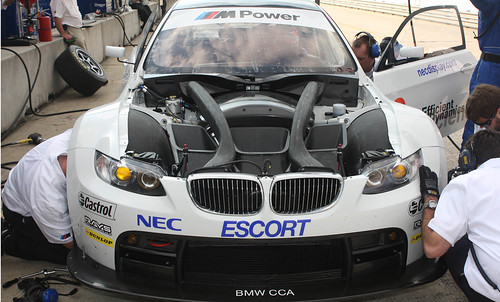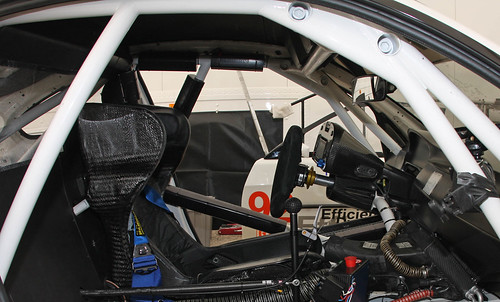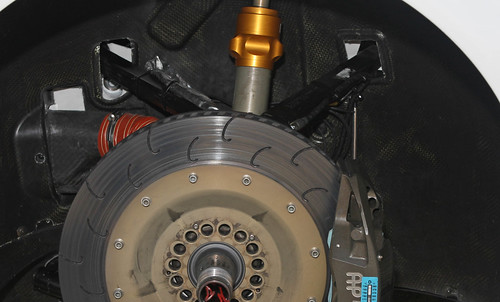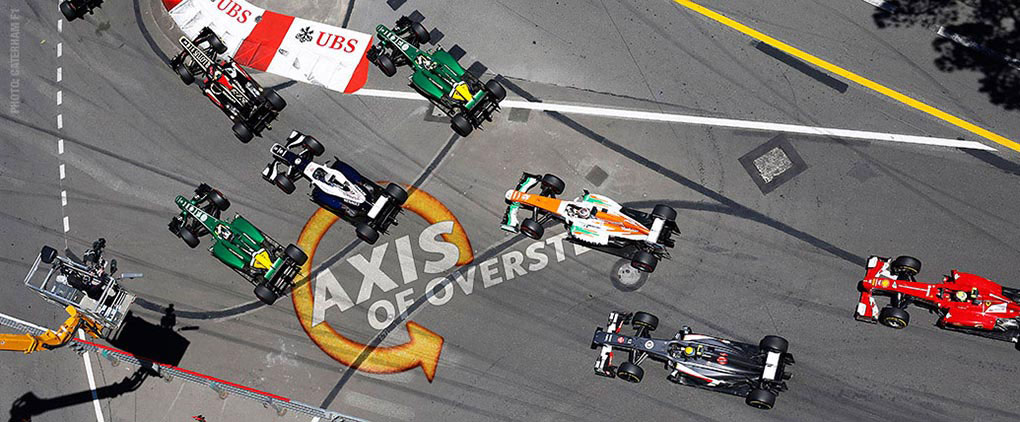



Or as Grumpy McFreep chastised me for, the BMW-RLR M3...
You will immediately notice double A arms rather than McPherson struts and an engine mounting position which makes the Rahal-Letterman Racing entry closer to a mid-front layout. But most intriguing is the shifter linkage going towards the rear of the car making it likely that BMW used a transaxle design for the GTR. And let's not forget the classic VW Golf shift knob.
Brian Watts , a club racer and poster at Bimmerforums.com, points out how the front half of the drivers compartment is closed off from the rear with a plexy bulkhead. He speculates this is to have a smaller area to cool with the air aonditioning units mandated by ALSM from this year.
So, not very much in common with your garden variety M3 but extremely cool. I wonder if Porsche will protest or run?
If you want to see more and oogle at all carbon fiber goodness, check the SLIDESHOW HERE or head over to the Axis Flickr page where you'll find 2650x1600 sized pictures.
The BMW M3 Race Version: Sportiness personified.
In the course of developing the race version of the BMW M3, BMW’s engineers were faced with an ambitious task: to improve upon the sportiness of an already sporting car. A better base would, though, be difficult to find. In standard form the vehicle delivers powerful dynamics and sporting aesthetics. Thanks to an eight cylinder engine producing 414 bhp, BMW’s customers are provided with a unique driving experience.
Those engine blocks, cast in BMW’s light alloy foundry in Landshut – the very source of BMW’s Formula One castings – selected for race duty need to withstand even more power: the BMW P65 race engine delivers 485 bhp.
In order to enable the BMW M3 to make full use of this performance on the race circuit, the experts in Munich have not concentrated solely on the engine, but have race-tuned the chassis as well. The race version of the BMW M3 is wider and significantly lighter than its production equivalent, enabling it to perfectly transmit the power of its V8 to the track. Widespread use of carbon-reinforced plastic (CRP) provides proof of substantial weight reduction. As with the production version, the race car’s roof is manufactured from this high-tech material.
The race version of the BMW M3 is clearly aimed at the top echelon of motorsport. As such, it is no surprise to discover that in the course of its development, begun in mid-2007, numerous Formula One techniques were applied. These include computational fluid dynamics (CFD) and wind tunnel analyses, both of which have ensured the best possible aerodynamic package for the BMW M3.
Intelligent control systems have been incorporated throughout the BMW M3. The POWER400 control unit actuates all the accessories fitted to the car, such as lights, wipers, etc., via two bus systems. Traditional relays and fuses are thus eliminated, ensuring considerable weight saving, improved reliability and ease of application. The functions of the BMW P65 engine are managed by an ECU 408 electronic control unit, developed in-house by BMW Motorsport. The software and applications, too, have been developed by the experts in Munich.
Technical Specifications of the M3 Race Version.
Weight 2,535 lbs./1150 kg
Tank capacity: 29 gallons/110 Liters
Chassis/body: Unitary construction steel body with welded safety cell made of extremely rigid precision steel tubing; safety fuel tank in CRP sandwich tray; pneumatic four-stamp jack system
Aerodynamics: Front fenders, rear apron, hood, roof, trunk lid, rear wing, front wings, and flared rear wheel arches in CRP
Transmission: Carbon fiber clutch with hydraulic central slave cylinder;
6-speed sequential racing transmission with straight-cut, unsynchronized gears;
additional oil/air cooler; quick shift system with ignition cut-out controlled by shifting force; mechanical limited slip differential with additional oil/air cooler
Front axle: Based on production version, with increased wheel caster angle, enlarged track width and enhanced wheel camber; five-way adjustable shock absorbers; tubular stabilizer bar
Rear axle: Based on production version, with enlarged track width and enhanced wheel camber; five-way adjustable shock absorbers, tubular stabilizer bar
Front brake system: Six-piston aluminum brake calipers, inner-vented grey-cast iron brake disks 15.0 in./380mm in diameter
Rear brake system: Four-piston aluminum brake calipers, grey-cast iron brake disk, 13.1 in./332mm in diameter
Steering: Rack and pinion steering with electro-hydraulic power
Wheels: Aluminum wheels, 18 inches
BMW P65 Engine.
Type: Eight cylinder, V-configuration
Capacity: 3999 cc
Bore x stroke: 92 x 75.2 mm/3.62 x 2.96 in.
Max. output: approx. 485 bhp
Max. torque: approx. 368 lb-ft/500 Nm
Cylinder block: Aluminum cylinder block construction with bed plate lower section
Crankshaft: Steel crankshaft
Pistons: Forged skirt pistons
Conrods: High-performance steel
Cylinder head: Aluminum DOHC (Double Over Head Camshaft); four valves per cylinde
Valve train: Four overhead chain-driven camshafts, valve actuation via rocker arms
Intake system: Eight throttle valves, made of CRP with load-charge optimized ram tubes
Exhaust system: Headers, mufflers
Fuel system: Single cylinder multi-point injection
Lubrication: Dry sump lubrication
Cooling: Water/air cooler and oil/water heat exchanger
Electrics/Electronics.
Engine management: BMW Motorsport ECU 408 with two high-performance micro-processors; Individual cylinder injection and ignition; BMW Motorsport Lambda Controller; Pit speed limiter, Quick Shift function;
Engine data memory system
Energy management: Electric energy management and monitoring with BMW Motorsport POWER400 control unit, networking of all sensors and actuators through bus system
Wiring harness: Weight optimized
Ignition coil: Eight high-performance pencil coils with integrated ignition drivers
Spark plugs: High-performance spark plugs
Cockpit: Free programmable LCD Display with integrated shift indicators
Steering wheel: Quick release multi-function steering wheel w/ integrated display unit
Steering: Rack and pinion steering with electro-hydraulic power
Wheels: Aluminum wheels, 18 inches
If you want to see more and oogle at all carbon fiber goodness, check the SLIDESHOW HERE or head over to the Axis Flickr page where you'll find 2650x1600 sized pictures.
The BMW M3 Race Version: Sportiness personified.
In the course of developing the race version of the BMW M3, BMW’s engineers were faced with an ambitious task: to improve upon the sportiness of an already sporting car. A better base would, though, be difficult to find. In standard form the vehicle delivers powerful dynamics and sporting aesthetics. Thanks to an eight cylinder engine producing 414 bhp, BMW’s customers are provided with a unique driving experience.
Those engine blocks, cast in BMW’s light alloy foundry in Landshut – the very source of BMW’s Formula One castings – selected for race duty need to withstand even more power: the BMW P65 race engine delivers 485 bhp.
In order to enable the BMW M3 to make full use of this performance on the race circuit, the experts in Munich have not concentrated solely on the engine, but have race-tuned the chassis as well. The race version of the BMW M3 is wider and significantly lighter than its production equivalent, enabling it to perfectly transmit the power of its V8 to the track. Widespread use of carbon-reinforced plastic (CRP) provides proof of substantial weight reduction. As with the production version, the race car’s roof is manufactured from this high-tech material.
The race version of the BMW M3 is clearly aimed at the top echelon of motorsport. As such, it is no surprise to discover that in the course of its development, begun in mid-2007, numerous Formula One techniques were applied. These include computational fluid dynamics (CFD) and wind tunnel analyses, both of which have ensured the best possible aerodynamic package for the BMW M3.
Intelligent control systems have been incorporated throughout the BMW M3. The POWER400 control unit actuates all the accessories fitted to the car, such as lights, wipers, etc., via two bus systems. Traditional relays and fuses are thus eliminated, ensuring considerable weight saving, improved reliability and ease of application. The functions of the BMW P65 engine are managed by an ECU 408 electronic control unit, developed in-house by BMW Motorsport. The software and applications, too, have been developed by the experts in Munich.
Technical Specifications of the M3 Race Version.
Weight 2,535 lbs./1150 kg
Tank capacity: 29 gallons/110 Liters
Chassis/body: Unitary construction steel body with welded safety cell made of extremely rigid precision steel tubing; safety fuel tank in CRP sandwich tray; pneumatic four-stamp jack system
Aerodynamics: Front fenders, rear apron, hood, roof, trunk lid, rear wing, front wings, and flared rear wheel arches in CRP
Transmission: Carbon fiber clutch with hydraulic central slave cylinder;
6-speed sequential racing transmission with straight-cut, unsynchronized gears;
additional oil/air cooler; quick shift system with ignition cut-out controlled by shifting force; mechanical limited slip differential with additional oil/air cooler
Front axle: Based on production version, with increased wheel caster angle, enlarged track width and enhanced wheel camber; five-way adjustable shock absorbers; tubular stabilizer bar
Rear axle: Based on production version, with enlarged track width and enhanced wheel camber; five-way adjustable shock absorbers, tubular stabilizer bar
Front brake system: Six-piston aluminum brake calipers, inner-vented grey-cast iron brake disks 15.0 in./380mm in diameter
Rear brake system: Four-piston aluminum brake calipers, grey-cast iron brake disk, 13.1 in./332mm in diameter
Steering: Rack and pinion steering with electro-hydraulic power
Wheels: Aluminum wheels, 18 inches
BMW P65 Engine.
Type: Eight cylinder, V-configuration
Capacity: 3999 cc
Bore x stroke: 92 x 75.2 mm/3.62 x 2.96 in.
Max. output: approx. 485 bhp
Max. torque: approx. 368 lb-ft/500 Nm
Cylinder block: Aluminum cylinder block construction with bed plate lower section
Crankshaft: Steel crankshaft
Pistons: Forged skirt pistons
Conrods: High-performance steel
Cylinder head: Aluminum DOHC (Double Over Head Camshaft); four valves per cylinde
Valve train: Four overhead chain-driven camshafts, valve actuation via rocker arms
Intake system: Eight throttle valves, made of CRP with load-charge optimized ram tubes
Exhaust system: Headers, mufflers
Fuel system: Single cylinder multi-point injection
Lubrication: Dry sump lubrication
Cooling: Water/air cooler and oil/water heat exchanger
Electrics/Electronics.
Engine management: BMW Motorsport ECU 408 with two high-performance micro-processors; Individual cylinder injection and ignition; BMW Motorsport Lambda Controller; Pit speed limiter, Quick Shift function;
Engine data memory system
Energy management: Electric energy management and monitoring with BMW Motorsport POWER400 control unit, networking of all sensors and actuators through bus system
Wiring harness: Weight optimized
Ignition coil: Eight high-performance pencil coils with integrated ignition drivers
Spark plugs: High-performance spark plugs
Cockpit: Free programmable LCD Display with integrated shift indicators
Steering wheel: Quick release multi-function steering wheel w/ integrated display unit
Steering: Rack and pinion steering with electro-hydraulic power
Wheels: Aluminum wheels, 18 inches

sex
ReplyDeletesame shift knob as the 320Si
ReplyDeleteUm, yes, it's the BMW Motorsport shift knob and has been in the catalog for eons.
ReplyDeleteFurthermore, it's the BMW-RLR M3.
-Freep (haven't had my coffee yet)
I think Kamei made shifts knobs for both BMW and VW. But Ive only seen them come on old Rabbits and GTI's.
ReplyDeleteAlso I dont think Porsche will protest anything. There new RSR Is just as radical if not more then this M3.
Alright Grumpy McFreep...
ReplyDeleteKnob
Look at that sweet yet fearful face of a beemer..i love it! Great blog.
ReplyDeleteengine management is awful i think
ReplyDeletelook at the transmission
ReplyDelete